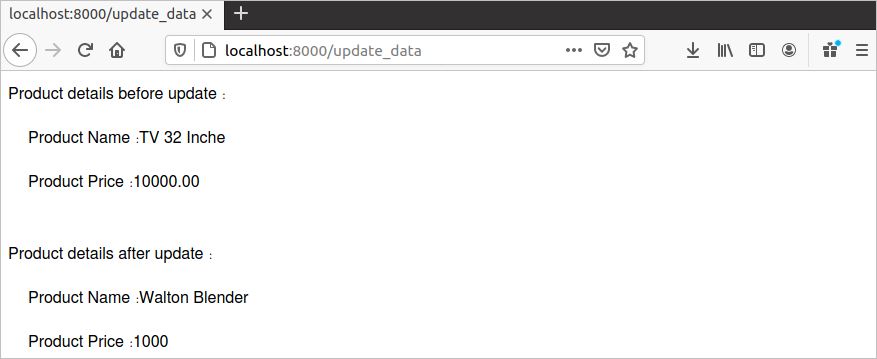Prerequisites
Before starting this tutorial, you must perform the following tasks:
- Install a new copy of the Laravel project
- Make the database connection
Create Tables
To complete the steps of the tutorial, you must create two tables in the database. These are the manufacturer’s table and the products table. The relationship between these two tables will be one to many, respectively. Run the following command to create the migration file for creating the structure of manufacturers table.
Open the migration file from database\migration folder and modify the up() method with the following code. The table will contain six fields: ID, name, address, phone, created_at, and updated_at.
{
Schema::create('manufacturers', function (Blueprint $table) {
$table->id();
$table->string('name')->unique();
$table->text('address');
$table->string('phone');
$table->timestamps();
});
}
Run the following command to create a migration file for creating the structures of the products table.
Open the migration file from the database\migration folder and modify the up() method with the following code. The table will contain seven fields: ID, name, price, manufacturer_id, created_at, and updated_at. Here, manufacture_id is a foreign key for the products table.
{
Schema::create('products', function (Blueprint $table) {
$table->id();
$table->string('name')->unique();
$table->decimal('price', 10, 2);
$table->bigInteger('manufacturer_id')->unsigned();
$table->foreign('manufacturer_id')->references('id')->on('manufacturers');
$table->timestamps();
});
}
Run the following migrate command to create the tables in the database.
Create Models
You must also create two models, named Manufacturer and Product, for the previously created tables. Run the following command to create the Manufacturer model.
Open the model from the app folder and modify the code with the following code. $fillable is used to define the mandatory fields of the manufacture table. The products() method is used to set the relation type with the products table.
namespace App;
use Illuminate\Database\Eloquent\Model;
class Manufacturer extends Model
{
protected $fillable = [
'name', 'address', 'phone',
];
public function products()
{
return $this->hasMany('App\Product');
}
}
Run the following command to create the Product model.
Open the model from the app folder and modify the code with the following code. $fillable is used to define the mandatory fields of the products table. The manufacturers() method is used to set the relation type with the manufactures table.
<?php
namespace App;
use Illuminate\Database\Eloquent\Model;
class Product extends Model
{
protected $fillable = [
'name', 'price','manufacturer_id'
];
public function manufacturers()
{
return $this->belongsTo('App\Manufacturer');
}
}
Create Controllers
Run the following commands to create ManuController and ProductController.
$ php artisan make:controller ProductController
CRUD operations using Eloquent ORM
The CRUD operations are shown below by first adding methods to these two controllers.
Inserting Data
Manufacturer Table
Add the Manufacturer model at the top of the ManuController. Next, add the following code inside the ManuController model to insert two records into the manufactures table.
{
Manufacturer::create([
'name' => 'ABC Trade',
'address' => '34, Mirpur, Dhaka',
'phone' => '01878562323'
]);
Manufacturer::create([
'name' => 'Rahim Afroze',
'address' => '123, Dhanmondi, Dhaka',
'phone' => '01878562900'
]);
echo "Manufacturer data inserted";
}
Add the following route in the routes\web.php file to execute the create_data() method.
The following output will appear after entering the URL below in the browser.
http://localhost:8000/manu
Product Table
Add the Product model at the top of the ProductController. Next, add the following code inside the ProductController to insert three records into the products table.
{
Product::create([
'name' => 'TV 32 Inche',
'price' => 10000,
'manufacturer_id' => 1
]);
Product::create([
'name' => 'Walton Fridge',
'price' => 20000,
'manufacturer_id' => 1
]);
Product::create([
'name' => 'IPS 7832',
'price' => 25000,
'manufacturer_id' => 2
]);
echo "Product data inserted";
}
Add the following route in the routes\web.php file to execute the index() method.
The following output will appear after entering the URL below in the browser.
http://localhost:8000/product
Select Data
Add the following method inside the ManuController to retrieve all records of the manufactures table and the related records of the products table.
{
$manufacturers= Manufacturer::all();
foreach ($manufacturers as $manu) {
$products= Product::where('manufacturer_id', $manu->id)->get();
echo "<b>Manufacturer: $manu->name</b><br/>";
foreach ($products as $pro)
{
echo "<p style='padding-left:20px'>Product Name:$pro->name</p>";
echo "<p style='padding-left:20px'>Product Price:$pro->price</p><br/>";
}
}
}
Add the following route in the routes\web.php file to execute the select_data() method.
The following output will appear after entering the URL below in the browser.
http://localhost:8000/product_detail
Update Data
Add the following method inside the ManuController to update the record of the products table that contains id value 2.
{
$product= Product::find(2);
echo "Product details before update:<br/>";
echo "<p style='padding-left:20px'>Product Name:$product->name</p>";
echo "<p style='padding-left:20px'>Product Price:$product->price</p><br/>";
$product->name = 'Walton Blender';
$product->price = 1000;
$product->save();
echo "Product details after update:<br/>";
echo "<p style='padding-left:20px'>Product Name:$product->name</p>";
echo "<p style='padding-left:20px'>Product Price:$product->price</p><br/>";
}
Add the following route in the routes\web.php file to execute the update_data() method.
The following output will appear after entering the URL below in the browser.
http://localhost:8000/update_data
Delete Data
Add the following method inside the ManuController to delete multiple records from the products table and a single record from the manufacturers table.
//Delete multiple data
Product::destroy([1, 2]);
//Delete single data
Manufacturer::destroy(1);
echo "Data are deleted.";
}
Add the following route in the routes\web.php file to execute the delete_data() method.
The following output will appear after entering the URL below in the browser.
http://localhost:8000/delete_data
Video Tutorial
Conclusion
This tutorial showed you how to create relationships between tables and how to implement CRUD operations using Eloquent ORM. Even new Laravel users will be able to understand some basic uses of Eloquent OPM after reading this tutorial.





